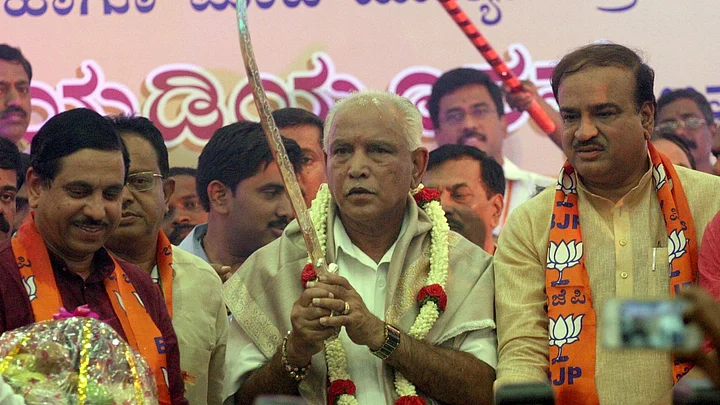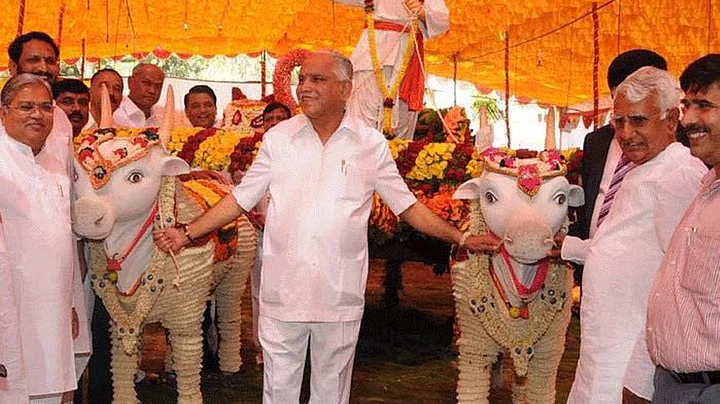Ahead of the assembly polls in Karnataka, the BJP is the only party to have announced a chief ministerial candidate. Even though several BJP leaders, like Anantkumar Hegde, are becoming popular in the party cadre and public, BJP is still sticking with BS Yeddyurappa as their candidate for the post.
Despite corruption charges – of which he was later absolved – a rebellion which led him to float a rebel party in turn, causing a serious dent in BJP’s performance and making room for Congress’ victory last election, Yedyurappa was relaunched by Modi, appeased and promoted to the Centre and now, he’s back where he belongs – in the state political arena.
So why is Yeddyurappa important to the BJP and why is he powerful? The answer lies in is his caste politics.
There could be other BJP leaders who are popular among the party workers, but it is Yeddyurappa who is the mass leader. He is the tallest leader for the Lingayat community, which is the largest vote bank in the state. And his rise to the position of a formidable Lingayat leader in Karnataka is result of the several decades of political events in the state’s history.
Who Are Lingayats?
Although the exact numbers are not known, Lingayats constitute almost 20 percent of Karnataka’s population.
In the 12th century, social reformer Basavanna introduced the Lingayat community, distancing themselves from Veerashaivas who followed the vedas and supported the caste system.
The new Lingayat community, instead of temple worship and casteism, were taught to worship Shiva with great rigour, and give up the ritualistic brahmin practices. Yeddyurappa, although a Lingayat leader, has been seen performing Vedic Yagas.
The progressive nature of the new community attracted many followers from across the society. Following the death of Basavanna, over centuries, the two communities –Veerashaiva and Lingayat – merged again riding on the common thread that both worshiped Shiva, notwithstanding differences.
In the 21st century, the terms Lingayat and Veerashaiva have been used synonymously.
Although there is a movement to get religious status for the Lingayat community, Yeddyurappa is believer of the idea that both communities are same and a part of the Hindu religion.
From a Clerk to a Lingayat Leader

Bookanakere Siddalingappa Yeddyurappa was born in Mandya district in 1943. However, his political career didn’t take off in his hometown, but in Shimoga district.
His first association with his political home-ground began when he joined the social welfare department as first-division clerk in 1965 and was posted in Shimoga district.
After working in the department for less than a year, he left, quit the job to join a private firm, Veerabhadra Shastri's Shankar rice mill, as a clerk. Within a year he married the daughter of the mill owner and started a hardware store.
Throughout this time, he was a member of the Rashtriya Swayamsevak Sangh (RSS) and it was the promotion as the secretary of RSS’s Shikaripura branch in Shimoga, that kick started his political career.
The Rise to Power
In the years that followed, Yeddyurappa saw periodical promotions in his political career.
Contesting on a ticket from Jana Sangh party ticket, which was the then political arm of RSS, he was elected to the Shikaripura Town Municipality. Two years later he became the President of the Town Municipality of Shikaripura.
In 1977, when the BJP was formed, he was made the president of the Shikaripura unit and subsequently the president of Shimoga in 1985. In 1988, he became the State President of the BJP in Karnataka. Since then he has elected to Karnataka legislative assembly six times. In 1994, he became the leader of opposition and finally the chief minister in 2006.
As his career in the BJP blossomed, a series of events in Karnataka politics paved the way for him to become the Lingayat leader of today.
Lingayat Leader by Coincidence

In Karnataka, Yeddyurappa is the tallest leader of the Lingayat community, constituting the largest vote bank. But until 2004, Yeddyurappa was more of a farmer leader than a Lingayat leader.
His emergence as the Lingayat leader was more of a coincidence. Over the decades, a series of events consisting of party splits, party mergers, coalition and deaths of leader, resulted in Yeddyurappa becoming the face of the Lingayat community.
The Split and The Merger
The Lingayat votes were traditionally with the Congress party. In 1969, the Congress party split into two factions. Those who supported Indira Gandhi became Congress (I) and those who opposed her became Congress (O). Following this split, most of senior Lingayat leaders went to Congress (O).
Year after, following the Emergency, the Janata Party was formed. As it was opposed to Indira Gandhi, leaders of Congress (O) merged with Janata Party. Along with Lingayat leaders Nijalingappa and Ramakrishna Hegde, a majority of Lingayat votes were also transferred to the Janata Party.
Dismissal of Veerendra Patil
Another event that led to further consolidation of the Lingayat votes was the dismissal of a Lingayat Chief Minister Veerendra Patil.
Patil was among the Lingayat leaders who moved Janata Party from Congress (O). However, he later moved back to Congress party and in 1989 was made the chief minister of Karnataka.
However, Patil took ill and the then Prime Minister Rajiv Gandhi dismissed him as the chief minister. More than removing him from power, it was how he removed him from the post that led to a controversy. It is alleged that the decision was made by Rajiv Gandhi at the Bengaluru airport, without even consulting Patil.
This was taken as a humiliation by the Lingayat community in the state and the community’s affiliation with the Janata Party grew.
The Janata Party Split And Entry of Yeddyurappa
In 1988 the Janata Party and other smaller parties merged to form the Janata Dal (JD). With the consolidation of Lingayat votes inherited from Congress (O) and Vokkaliga votes under leadership of HD Devegowda, Janata Dal came to power in 1994 in Karnataka.
However, because of the differences, the Janata Dal split into JD(S) and JD(U). While JD(S) was under the leadership of Gowda, Lingayat leaders JH Patil and Ramakrishna Hegde were the faces of JD(U).
JD(U) subsequently lent its support to the BJP in Karnataka.
By 2004, when BJP emerged a prominent party in the state, JH Patil had passed away and Hegde had retired from active politics. As the Congress was led by a Vokkaliga Chief Minister SM Krishna, a vacuum was created for a Lingayat leader and that’s where Yeddyurappa stepped in.
(At The Quint, we are answerable only to our audience. Play an active role in shaping our journalism by becoming a member. Because the truth is worth it.)
